Pre-Railway Communities / The Souris River Communities
|
By
1879 some Ontario settlers came by Assiniboine River steamboats and
embarked where the Souris River entered near where Treesbank later was
established. Two villages grew, one close to the Souris Mouth called
Millford, and another near where Wawanesa is todayl, called Souris
City. Both these settlement were important in that they were staging
areas for settled venturing south to the Turtle Mountain region and
south west to the Hartney area. Both places were surveyed as
towns and lots were sold on the markets in Winnipeg. Both grew with
confidence and established important business services. Both had
stores, blacksmith shops and hotels as well flour mills and sawmills.
The most unique flour mill wasn’t in a village at all. John Gregory bypassed the existing villages and selected what he thought was the best riverside location in terms of the potential for water power. Millford The town was the brainchild of a Major R.Z. Rogers from Grafton, Ontario. He happened to have a brother-in-law, Mr. E.C. Caddy who was to lead a team of Dominion Surveyors to southwestern Manitoba in 1879. He asked him to keep an eye out for a site for a sawmill and gristmill. His dream was to start a new community and to profit from the next wave of expansion to the west. [5] A warehouse constructed by Major Rogers near the junction of the Assiniboine and Souris met a similar fate. His plan to capitalize on the location and establish Millford as a trading centre for the region was underway quickly. His gristmill, which was once described as a “small portable” one, (2) was up and running, and farmers were hauling their grain to him. Percy Criddle thought his prices were a bit high compared to Brandon but appreciated the convenience of dealing locally. He needed storage near the waterway but high water carried it away in 1881. He rebuilt and in 1882 again lost it and it’s considerable contents down the river. 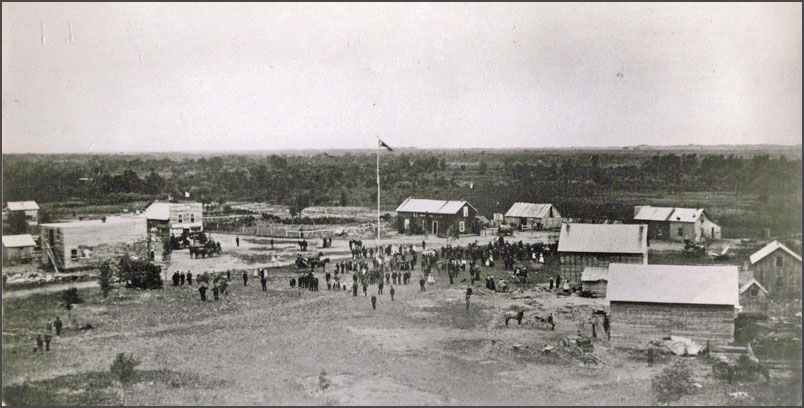 Millford as it looked in about 1883. 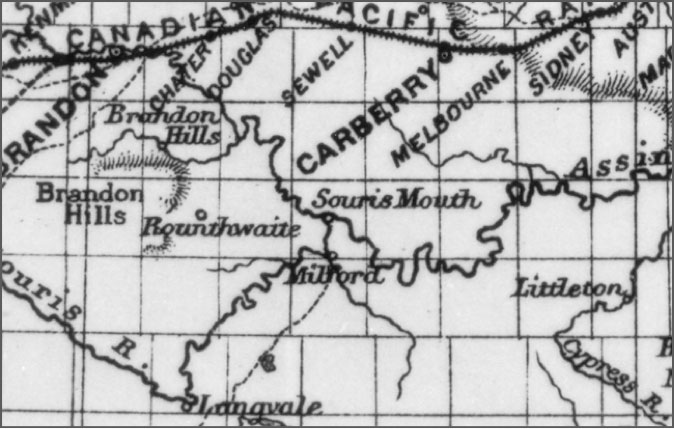 The Millford region. Souris City At its birth, Souris City was one of many speculative “cities” that came with the Manitoba Land Boom of 1881-82. In this case it almost paid off. 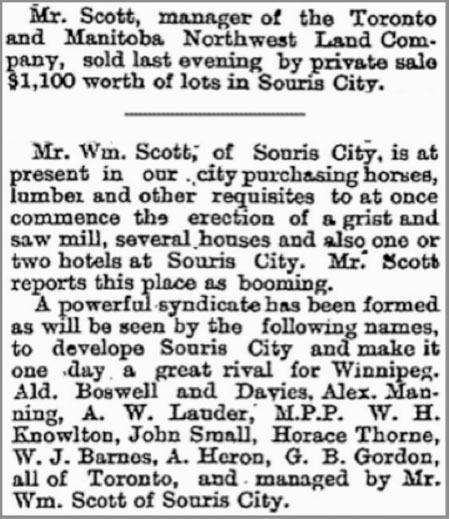 Winnipeg Daily Sun, Jan. 26, 1882 The survey plan, which was ambitious even for these times of wild speculation, included parts of to sections of land and planned lots on both sides of the river. but the actual settlement was in the southwest corner of that deep loop in the river, and at its best was a somewhat scattered village with its buildings strung out along the river bank. The gamblers in this case were William Scott and his son William J. They arrived sometime after October 1880 and bought land from the CPR. Early in 1882 the Winnipeg Daily Sun reports that, ”Mr. Scott, Manager of the Toronto and Manitoba Northwest Land Company, sold last evening by private sale $1100 worth of lots in Souris City.” The next month an ad offered 320 acres adjacent to Souris City for sale. The gristmill, which was steam powered, was located along the river on the east side of the flats. Local farmers had been hauling grain to Millford for this purpose, and for farmers to the southeast the trip to Souris City was shorter and over an easier trail. Some local histories speculate that this mill is one and the same with the Gregory Mill located a few miles upstream, but a report in the Brandon Sun in 1889 contains explicit references to both mills. The likelihood is that the mill at Souris City was not nears as large an operation as Mr. Gregory’s and served a purely local need. 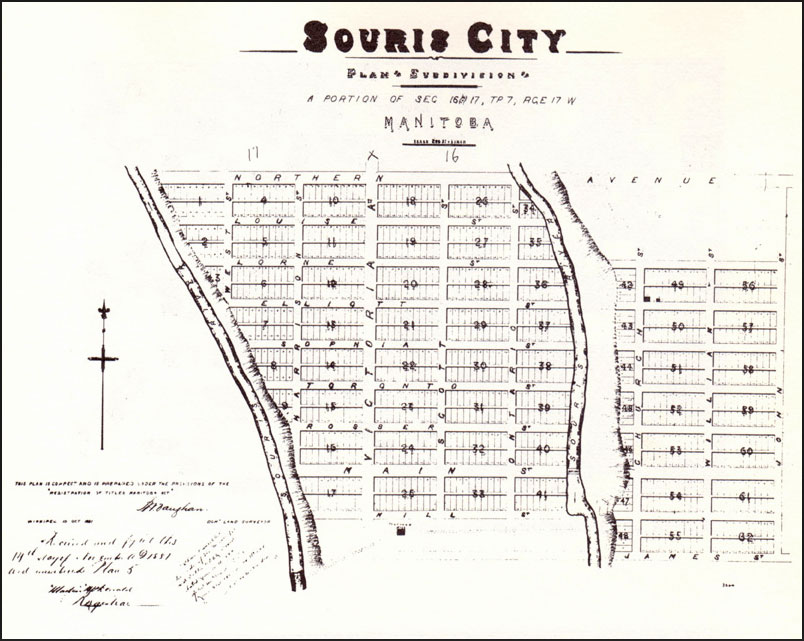 The Souris City plan, as registered in 1881 The town is mentioned often in early newspaper reports, being on a well-used trail south from Brandon and Millford, and the site of a ferry crossing and later a bridge. When Northern and Pacific Railway completed their new line from Morris to Brandon, they decided to cross the river a few miles downstream. The new town of Wawanesa came into being without a great deal of fanfare. Home and business owners wasted no time. During the winter of 1890 most of the buildings were put on skids and dragged them to the new town of Wawanesa 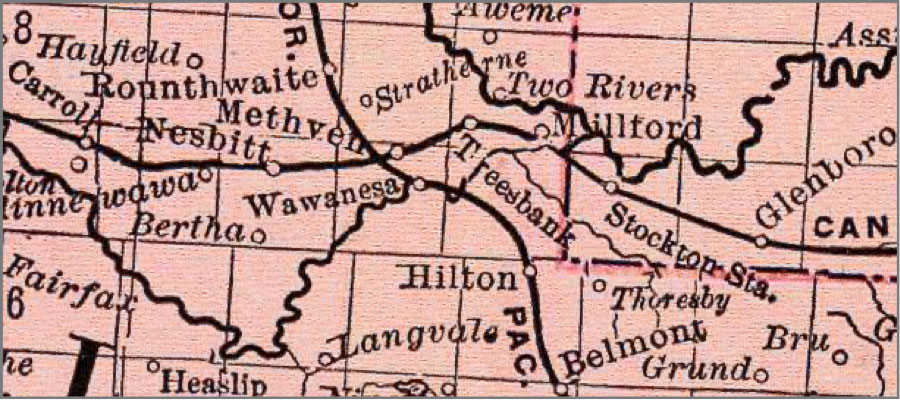 On this map from 1892 Souris City has disappeared and Wawanesa is well-established. Gregory’s Mill The story of John Gregory’s mill is the story of a mill that wanted to be a town. It is a noteworthy story for several reasons. It was the most important mill south of the Souris River for over a decade. It was the most substantial industrial investment seen in the pre-railroad era in Westman. Although Mr. Gregory did install a steam engine to compensate for Manitoba’s season rivers, his design was the most ambitious attempt to harness the waterpower of the Souris River for industrial purposes. Fortunately, enough evidence of the site remains for one to visualize the whole operation. And we have a few photos. 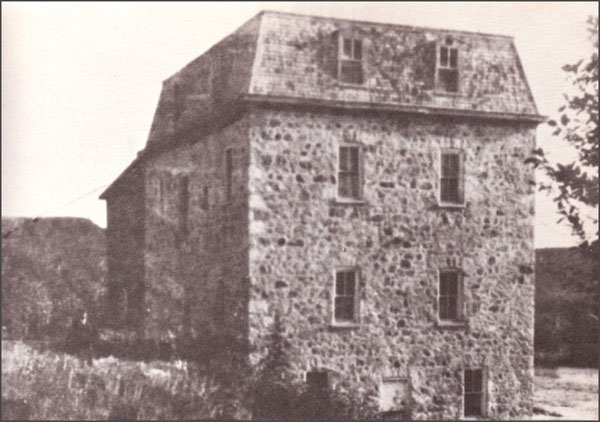 Gregory’s Mill (Photo scanned from “The Prairie W.A.S.P.) The story begins in 1882 when John D. Gregory, from Wingham, Ontario, came to Manitoba and began scouting locations for a mill site. In 1883 he took title and settled on a farm that straddled the Souris River about 8 kilometres upstream from were it now passes under Highway #2 near Wawanesa. He built a mud dam to back the water up to ensure a steady flow, erected an impressive stone mill building, set up the necessary equipment and opened for business. At that time he was 40 kilometres from the rail line but he hoped that it would come to him, or he saw the business as viable regardless. The first dam had a head of eight feet of water, and the mill building was said to have the “most improved machinery” and a capacity of 75 barrels per day. Newspapers of the mid 1880’s offer us more glimpses of Mr. Gregory and his mill and help to illustrate their respective places in the local community and its economy. A report from nearby Langvale in 1885 noted that the “flouring mill of Mr.Gregory” had been shut down due to low water, but that a “powerful engine” was being installed and that the mill would be running again in a “few days”. In June of that same year we note that Riverside Municipality had remitted Gregory’s taxes. This is something municipalities did as a way of supporting needed services. 1886 brought more expansion as a letter to the editor reported that ”the flouring mill at Whitehead is running full blast night and day” and that the “energetic proprietor” had just completed an addition to the facility. Also in 1886, rumours persisted that a rail line might cross the valley near the mill as Mr. Nichol of nearby Souris City reported that the railway engineer was coming back to ” try Gregory’s Mill crossing”. The Riverside History reports that the mill offered the latest in technology and that: “Customers had come to Gregory's Mill from all directions, some as far south as the U.S. border. The flour, of superior quality, milled by the "Hungarian Patent Process," was drawn to Brandon by mule team and horse teams, made three trips a week to the flour in a warehouse until a carload was gathered, to ship east by rail. On the return trip, they brought back provisions needed at the mill.” John MacAulay a member of the Crofter Settlement that arrived near Ninette in 1888 remembers that” At Gregory’s grist mill on the Souris the settlers received 40 pounds of flour to the bushel when their grain was gristed.” 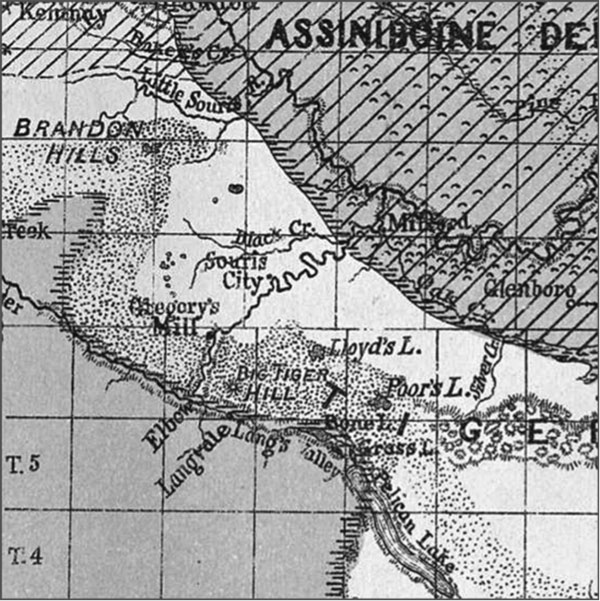 Warren Upham's 1890 map of the Lake Agassiz is a rare map from the era showing the Gregory’s Mill location. Note that the main communities are Millford, Souris City and Langvale. Scanned from The Historical Atlas of Manitoba Expansion & Competition In about 1888 he began a considerable expansion. A higher dam was constructed about a kilometre upstream. The first attempt was cut short when high water “carried away a piece of the west bank" but the work was completed and certainly must have been the foremost feat of engineering in rural Westman at the time. A report in the Brandon Sun described it thus: “The dam, is 600 feet long, 160 feet wide at its base and 29 feet at the top, is 30 feet high from the bed of the river, and is composed entirely of trees, brush, boulders gravel and earth, intermixed, forming an impenetrable mass, capable of resisting almost any pressure. Behind the dam there is now a body of water with a head of 28 feet, covering 5000 acres, and extending for 6 miles to the south. The race is 4000 feet long and from 6 to 18 feet; much of the material taken from this was used on the dam.” (Brandon Sun, 1891) There was a moderately sharp bend across which he could construct a “millrace” or channel to direct the flow to the mill. That millrace is still visible today and must be seen to be appreciated. One has to marvel at the engineering, and just sheer work, that must have been required. What equipment would they have to move that amount of earth? Where would they get such equipment - before the municipalities had even begun to plan the grid of gravel roads that were to appear with the advent of the automobile? Some stretches are gouged out of the hillside, while in other places the sides are built up like dikes. The whole enterprise must have involved a substantial effort - in time and money. The cost was 15000 dollars, an amazing amount of money for a local enterprise, but Mr. Gregory projected that he now had enough water backed up to allow for three month of operation during times of low water flow, and could boost his capacity to 125 barrel per day in the winter. But this expansion came just as there was bad news on the railway front! The End of an Era By 1889 not one, but two railways were about to cross the district. One was angling up from Morris to Brandon, and destined to cross the Souris River at Wawanesa while the existing line from Winnipeg to Glenboro was finally to be extended to Souris. 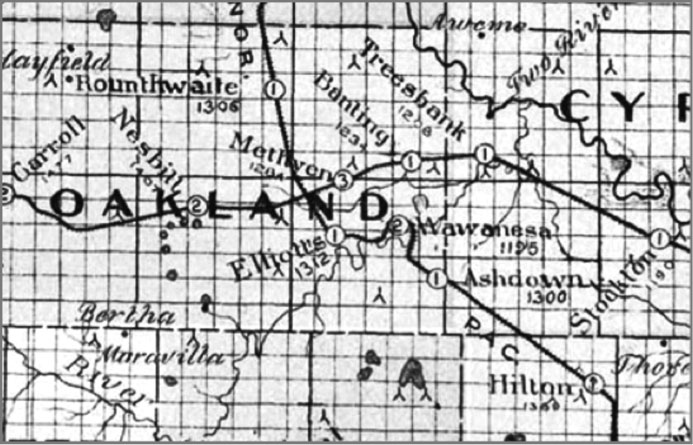 The region had two rail lines by 1891. The siding at Elliott's was the closest railway link for Mr. Gregory's flour, about eight kilometres away.  The mill race, a 1000 metre long ditch built to divert water from the Souris River to the mill wheel. 120 years after it was abandoned the mill race is quite visible today, even from Google Earth! 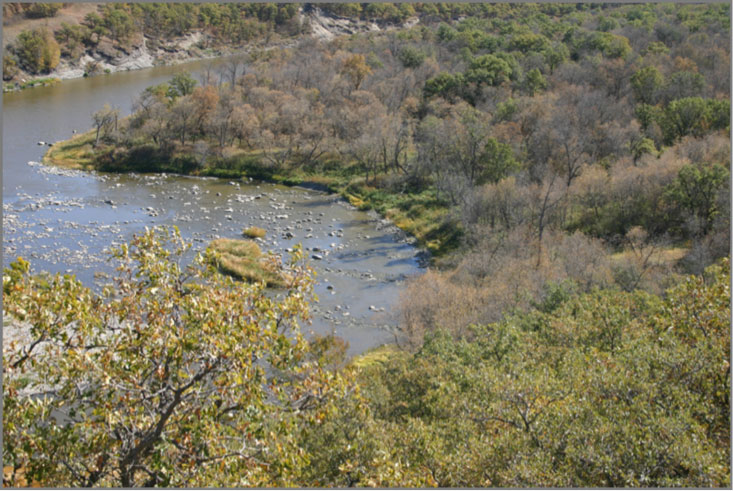 The mill was towards the bottom right corner of the picture and 10 metres up the bank. I believe that the first dam was here – likely designed to direct the flow to the right bank. Perhaps Mr.
Gregory was going to remain viable. The mill was obviously thriving in
1891 when we see a report from Belmont where they were “agitating for a
good grist mill” noting that “almost every day” teams passed through on
their way to Gregory’s which was 40 kilometres away. Despite the
fact that a closer rail line would have provided better access to
export markets, the mill was providing a valuable service to locals who
continued to patronize it.
In 1892 a notice by the Oakland council appeared in the Sun advising that there would be a vote on a bylaw to “grant a bonus of $1000 to John Gregory’s mill”. The article notes that: “Mr. Gregory intends increasing capacity to…250 barrel during the next year if he succeeds in getting better shipping facilities. At present he is five miles from the nearest railway station, but he is confident that he will be able to overcome that difficulty before long.” Well that “difficulty” never was overcome. The site of the Gregory’s Mill, today, as it was then, is still eight kilometres from what is now an abandoned rail line. As it turned out it likely wasn’t the lack of access to the export market that sealed the fate of Gregory’s Mill. It was the establishment of mills in the new population centres that sprang up along the new railways that spelled the end. For example, Glenboro got its mill in 1994. At Holmfield to the south, a mill was serving the Killarney and Boissevain district. Wawanesa soon offered a bonus get one started in that new village. There were no notices in the media of the day regarding the closing of the mill. Reference to it just ceased to appear, in much the same way that references to the abandoned towns of the settlement era just disappeared. Instead, what we learn from the newspapers is that mills were springing up elsewhere. And so was Mr. Gregory. By 1895 both Nesbitt and Wawanesa were interested in having him relocate to their towns. Later that summer he was hospitalized for a problem with his foot, which eventually led to amputation, and June 21 of the following year he died. When John Gregory bought his riverside property and started his operation he must have been a wealthy man. He is said to have died broke, having lost a hundred thousand dollars. The sight is now
difficult to find. Trees have surrounded what is left of the
foundation making it virtually invisible to a passer-by on the river.
The large stone that once served as a doorstep for the mill now rests
in the Minnewawa Cemetery near the junction of Highways Two and
Ten. A huge gear from the mill itself is in on display at the
Sipiweski Museum in Wawanesa, and a few other scattered remnants of the
machinery have found their way into private collections.
Plum Creek and Souris The story of the mill at Souris is another example of a gristmill being the catalyst for the growth of a town. Long before the town of Souris got its long – promised branch line, it was a prospering village. In 1880 William Henry Sowden, Thomas Gillespie Kells and John Nesbitt Kirchhoffer, members of the Millbrook Colonization Syndicate, acquired the property on Plum Creek near where it enters the Souris River. They did this because of its suitability for a mill site. The mill would justify the establishment of a settlement at what is now the Town of Souris. During the spring of this year, some 14 men, including Arthur Rose, were employed building a dam at the proposed Mill site on Plum Creek. The first house in Souris was built to accommodate the men who built the first mill dam. G. McCulloch and William Herriot were co-owners of the 1882 mill on Plum Creek. They thus established Souris as a trading centre At one time grain was hauled from as far away as Estevan to the mill. The flywheel from that mill still runs in the museum at Austin, Manitoba The building was completed by December of 1882, the machinery installed in February of 1883, and their enterprise in operation cleaning seed for the settlers of a wide area by the spring of 1883. In 1898, McCulloch and Herriot had become so successful at milling that they opened Western Canada's largest yellow brick flour mill. They shipped three brands of flour, independently, to eastern Canada and overseas: Ladies' Choice, Prairie Lily and Strong Bakers. 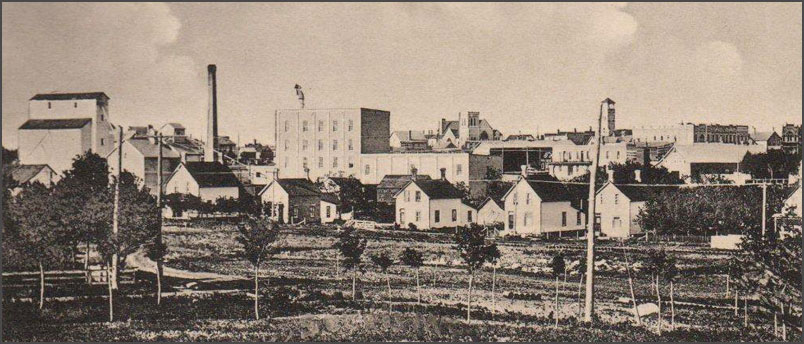 The Souris, with the mill prominent in the centre. Photo available in the Prairie Towns Collection. 1903 World markets recognized the
quality. Wheat became the economic
driver of the prairies. "Prairie Lily" flour produced by the McCulloch
and Heriot Mill was exported to Europe, was significant not only
locally but also on the world market.
|


